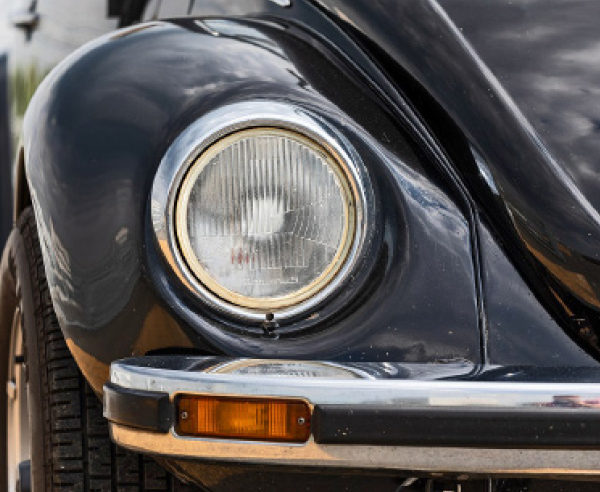
Image by Mike Bohan from Pixabay.
By Dermot Carmody
The iconic, and increasingly rare, rear-engined Volkswagen Beetle still catches the eye today if you come across one on the 21st century roads. This, despite the fact that it was based on a 1930s design by Ferdinand Porsche and started mass production in post-war German in the 1940s.
But not everyone will know that this car for the people has a strong historic connection with Dublin 4, and specifically with Shelbourne Road in Ballsbridge, where the first VW Beetle assembled in Ireland drove onto the road seventy years ago this year.
Since the 1890s, 162 Shelbourne Rd. in Ballsbridge has had a number of functions which reflect changes in transport in the capital city. It’s the site of MSL Ballsbridge Motors today, but it started out as an important part of the south Dublin tram system and became the site where the first Volkswagen car assembled anywhere outside of Germany, took place.
The site of the MDL Volkswagen assembly plant in Shelbourne Road had previously been an important component of the Dublin tram system. Dublin Southern District Tramways Company (DSDTC) had run the horse-drawn tram from Haddington Road to Blackrock since April 1879.
This later connected to Kingstown (Dun Laoghaire) and thence to Dalkey (though the trams couldn’t run direct, straight through from Haddington Road to Dalkey because the Kingstown to Dalkey line had been built using the British 4 feet gauge rather than the usual Irish 5 feet 3 inches gauge).
In 1893, the DSDTC, and the Blackrock and Kingstown tram companies were acquired by Imperial Tramway of Bristol and J Clifton Robinson was appointed managing director. Robinson re-laid the line from Kingstown to Dalkey in the 5 feet 3 inches gauge to allow a through service from Haddington Road to Dalkey. To facilitate the electric tram service, a new power plant and car shed was opened in Shelbourne Road on the 16th of May 1896. This tram line, run latterly by the Dublin United Tram Company, ran until the last tram to Dalkey in 1949.
The idea of an indigenous car assembly industry in Ireland may be strange to younger readers, but there was indeed such a thing. It was an indirect result of the Economic War with Britain in the 1930s.
In 1932, the Fianna Fáil government refused to continue paying annuities to the British government. These payments stemmed from an 1890 scheme to allow tenant farmers to buy out their farm from (mostly British) landlords.
Few could afford this, so the British government paid landlords, and farmers paid the government back through annuities. The Irish Free state government reckoned that as British landlords had no right to the land in the first place, then the British government shouldn’t be paid.
This sparked off a tariff war, with the smaller economy of Ireland coming off worse than the much larger British economy. Imports and sales of British-manufactured vehicles plummeted. Prior to this about 4,000 vehicles were being imported annually.
Enter Frederick Maurice Summerford, a founder member of the Irish Motor Agents Association. Summerford lobbied the then Minister for Industry and Commerce, Seán Lemass, to allow Complete Knock-down (CKD) kit versions of cars to be imported – with much less punitive tariffs than were imposed on pre-built foreign imports – for the purposes of assembling the cars in Ireland.
In 1933, Lemass agreed to amend the Finance Act accordingly and the Irish motor assembly industry was born. The industry was also helped by fixing a lower flat rate of motor taxation for Irish-assembled cars. (£16 versus £30.) Eventually this led to a plethora of car assembly businesses in Ireland, Ford in Cork and Brittans in Rathmines being well-known examples. And it was at Fords that the man behind the VW Beetle assembly in Shelbourne Road, Stephen O’Flaherty first worked in the motor trade.
O’Flaherty was born in Passage East in 1902 and worked in the accounts department at Ford in Cork in the late 1920s. He then moved to McCairns Motors in Dublin, rising to the position of Secretary and General Manager.
He left McCairn’s in 1939 to run Howard McGarry and Sons, an engineering business he’d purchased in Townsend St. By 1946 he had developed this into a motor business called Motor Distributors Ltd. (MDL). They assembled several marques including Adlers, Nash and Wallys CKD cars in Townsend Street.
O’Flaherty acquired the Volkswagen franchise for Ireland at the Paris Motor Show in 1949, signing the contract in Germany the following year. He moved from the Townsend Street premises to the old tram depot, now defunct following the tram line’s closure, of course, in Shelbourne Road and began VW Beetle assembly in 1950. Beetles were assembled at the Shelbourne Rd site from 1950 to 1952, when the company moved to a larger factory on the Naas Road.
The first Beetle assembled at Shelbourne Road was the first Volkswagen to be assembled outside Germany and is on display today in the Volkswagen Museum in Wolfsburg.
In 1950, 46 cars were assembled on the Shelbourne Road production line. Assembly of VW Beetles in Ireland had risen to 2,155 by 1952 and production of Beetles peaked at 5,288 in 1972. 3,000 to 4,000 Beetles were produced here on average until production of the model was discontinued by Volkswagen in Europe in 1977.
NewsFour would love to hear from anyone who worked in the MDL plant on Shelbourne Road, or whose relative(s) did. We would particularly like to see any photographs of the plant, which are hard to come by!



